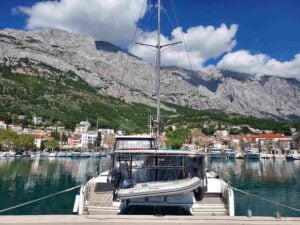When we crossed the border from Portugal (the Algarve) to Spain (the Southcoast of Spain), it was the 19th of December 2022. The first Spanish region (in the Netherlands we would call it province) we entered was Andalusia. It’s the largest of the 17 regions that Spain has divided her country in: about 8 million people live in Andalusia. So it was not until the end of January that we left Andalusia: when we sailed for the city of Cartagena, we sailed into the next region called Murcia (capital is the city of Murcia). Murcia is a much smaller region and has 2 beautiful areas that we visited: Cartagena and Mar Menor.

Cartagena
The city of Cartagena has a very interesting history. It was founded in 221 BC. by the North African army commander Hasdrubal, who found the city strategic to conquer more inland areas. The city was called ‘Qart chadast’ (New City), just like the city of Carthago in Tunesia. In 209 B.C. the Romans conquered the city and made it part of the Roman Empire under the name of Carthago Nova.
The Roman Theatre of Cartagena in Spain, was the largest amphitheatre in the Roman Empire: 11.000 visitors could be there! And in the rest of the city, there a lot of remains of the Roman period, it’s like an open air museum.


We cycled in the city and enjoyed the combination of old buildings and modern buildings (art nouveau and art deco) a lot.


The harbor was very close to the old city and with our drone we made a movie of the Roman Theatre and the view from there on the harbor:
Cabo de Palos
After Cartagena our intention was to sail into Mar Menor (in English ‘Little Sea’) which is a lagoon.
But this is typical how it goes in sailing: we made a plan to sail from Cartagena to Mar Menor, but during the trip the wind changed and this time in our disadvantage. The predictions were: a mild wind, 10 knots, coming from the East. But the wind became 16 knots, blowing from North East. That was exactly the direction we wanted to go. And you can’t sail against the wind. So Gilles started to adapt to the wind with what is called in sailing: crossing and tacking. The black line was our planned course, the green line was the actual course:

What should have taken us 4 hours, turned into 6 hours and still we were not at our destination! What made it worse, the waves were coming from another direction than the wind (east and not north east), so that made the ship bounce a lot in the water. It was not a comfortable trip and it would take us another 3 hours to go the entrance of Mar Menor. Then it would be dark and sailing in an unknown area is not something we like to do if we don’t have to (you don’t see fishing gear, buoys etc in the water).
So, let’s go to plan C, now that plan A and B were not working: finding a harbor to seek shelter. That turned out to be the small harbor of Cabo de Palos, 30 minutes away. We checked our Mediterranean Almanac (by Imray) which has a lot of information on winds, currents, but also harbors and it said: ‘Only 40 visitors berths, maximum length 10 meters and often full’. Ok, we have a ship of 12 meters, but it’s low season, let’s go for it, maybe we’ll find a spot’. And right at the entrance there was 1 spot left. We parked the boat, called the Marina office and hoped for the best. They were very friendly, and told us that their harbor is often used as a refuge by sailingboats to stay for 1 or 2 days and that was ok. It was free as well. We were very surprised: we expected to be send away, but we were very welcomed. So we were overjoyed and went to their nr 1 restaurant in town (El Rancho) which served excellent Iberian steak. We stayed for 2 days at the harbor of Cabo de Palos and made this video with our drone for the Club Náutico as a thank you for their hospitality!
Manor Menor
Then finally we headed for Mar Menor! The lagoon is separated from the Mediterranean Sea by a strip of land called La Manga del Mar Menor, which is 21 km long. The water in the lagoon is always warmer than the Mediterranean water because it is no more than 7 m deep, often only 4 to 5 meters. It was therefore declared “the largest swimming pool in the world” by the famous swimmer and Hollywood actress Esther Williams. This coastal area of Spain is also called ‘Costa Cálida’ (Warm Coast), which you can tell by the many sunny days, beaches and palmtrees.
To get into the Lagoon, you have to pass a bridge between an opening in the strip of land. It’s 4 meters high and for boats taller than 4 meters (our mast is 22 meters), the bridge opens every 2 hours in low seasons (10.00h, 12.00h, 14.00u, 16.00u). Again, thank you for the Mediterranean Almanac for that information! We got there 11.30u and waited for the bridge to open. We were the only ship to go under the bridge, so traffic had to stop for us, but after us the bridge closed quickly.

The Mar Menor was lovely: lots of kite surfers, windsurf boards, boats, palmtrees and 4 islands in the lagoon. We anchored at the north part of the inner lake and were sheltered from wind and swell. We only heard the birds and saw a beautiful sunset.







